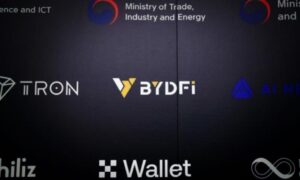In this TechBullion interview, we have the pleasure of diving into the dynamic world of Bitcoin mining with Kerri Langlais, the Chief Strategy Officer for TeraWulf Inc. With a commitment to developing fully integrated Bitcoin mining facilities in strategic locations across the United States, TeraWulf is revolutionizing the cryptocurrency landscape. Not only are they generating attractive investor returns, but they are also leaving a lasting positive impact on local communities.
Please tell us more about yourself and your background in the Bitcoin mining industry?
My name is Kerri Langlais, and I’m the Chief Strategy Officer at TeraWulf Inc. I have worked as an advisor, investor, and operator in the energy infrastructure space for over two decades. Given that power is the most significant cost component to mining a Bitcoin and the critical role that Bitcoin mining facilities can play in the transition and decarbonization of the electric grid, Bitcoin mining became a natural segway for our executive team. We’ve been working together for more than 15 years developing and operating energy infrastructure assets globally. We launched TeraWulf in 2020 with the mission to mine domestic Bitcoin sustainably and took the company public in December 2021.
How does Terawulf develop fully integrated Bitcoin mining facilities? Could you tell us more about the business and your specific services?
TeraWulf aims to generate Bitcoin at the lowest cost, utilizing 100% zero-carbon energy. With excellent power costs, an ideal climate, and meaningful immediate growth capacity, our two existing facilities, Lake Mariner and Nautilus, are among the best in the industry. We developed, built, and operated our facilities and mine Bitcoin using our miners (i.e., we are not a hosting business).
- The Lake Mariner facility located in Upstate NY is on the shores of Lake Ontario and mines Bitcoin using 91% zero-carbon resources, primarily from an abundant supply of hydroelectric power in that region (the facility is located 25 miles from the Niagara Hydroelectric power plant). Lake Mariner is currently operating 110 MW of Bitcoin mining capacity and is expanding to over 150 MW, as planned by year-end. The site has tremendous scalability, with the capacity to expand up to 500 MW.
- Our second site is the Nautilus Cryptomine facility in central PA, which we own in partnership with Talen Energy. The Nautilus facility represents the first Bitcoin mining facility in the U.S. to be directly connected to a nuclear power station behind the meter. TeraWulf is mining 50 MW at Nautilus, with the option to expand by another 50 MW.
As a fully integrated Bitcoin mining company, TeraWulf controls the site, the access to power, as well as the engineering and operations professionals who maintain and operate our facilities 24/7. We are not at the mercy of third-party suppliers or technicians to ensure our machines run efficiently and reliably around the clock. By being fully integrated, TeraWulf controls its destiny.
What sustainable benefits do Terawulf’s mining facilities bring to local communities in the United States?
Bitcoin mining requires energy to power the computers that verify and record cryptocurrency transactions. In some cases, this energy may come from burning coal or fossil fuels, a source of carbon emissions driving climate change. In contrast, TeraWulf’s sustainable Bitcoin mining facilities draw low-cost power from renewable energy sources such as hydroelectric and nuclear energy, emitting little or no carbon.
The largest renewable energy sources are typically in remote locations, making reaching load pockets difficult and costly. Bitcoin mining can be strategically sited in areas with stranded energy, taking a local commodity (electricity) and converting it into a global store of value (Bitcoin).
TeraWulf believes its access to inexpensive, zero-carbon power represents a meaningful and durable competitive advantage for the Company relative to its publicly traded Bitcoin mining peers.
Can you explain how Bitcoin mining works and its significance within the cryptocurrency industry?
Our industrial-scale Bitcoin mining operations focus on maximizing our ability to successfully mine Bitcoin by growing our hash rate (the amount of computer power we devote to supporting the Bitcoin blockchain) to increase our chances of successfully finding cryptographic hashes that create new blocks on the Bitcoin blockchain (a process known as “solving a block”). Generally, the greater share of the Bitcoin blockchain’s total network hash rate (the aggregate hash rate deployed to solve a block on the Bitcoin blockchain) represented by a miner’s hash rate, the greater the miner’s chances of solving a block and, therefore earning the block reward, which is currently 6.25 Bitcoin plus transaction fees per block. As additional miner operators enter the market in response to increased demand for Bitcoin, the Bitcoin blockchain’s network hash rate grows.
How does Terawulf ensure attractive investor returns from its Bitcoin mining operations?
As a vertically integrated zero-carbon mining company, WULF can mine Bitcoin more efficiently and profitably than any of our peers. We may then return that profit to shareholders through debt paydown, organic growth, or dividends and share buybacks. We are uniquely aligned with our shareholders; in fact, over 50% of the equity is owned by TeraWulf’s management, Board, and insiders.
What strategic locations across the United States does Terawulf choose for their mining facilities, and why? Do you have any success stories to share?
As mentioned above, our existing Bitcoin mining facilities are in NY and PA, with significant opportunities to scale. We believe there is value in regional diversification. We will opportunistically pursue incremental sites with an energy supply/demand imbalance, access to abundant, low-cost, zero-carbon energy resources, and scalability.
The Lake Mariner facility in NY is a unique story, as it was once home to the last operating coal plant in the State. Our team worked with the State to retire the coal plant in 2020 and have successfully redeveloped the site as a Bitcoin mining facility. It serves as an energy sink to the abundant supply of low-cost hydropower that cannot travel to the load pockets downstate in New York City, thereby serving as an effective grid stabilizer. The facility has also provided jobs to many people who once operated the coal plant.
How can individuals get involved with or invest in Terawulf’s Bitcoin initiatives within the United States?
- Watch our site tour video on YouTube
- Follow us on Twitter @TeraWulfInc.
- Check out our website, www.terawulf.com, and join our newsletter.
What measures does Terawulf take to ensure security and efficiency in their Bitcoin miners’ operations?
We store and safeguard our self-mined Bitcoin in a cold storage wallet held by our custodian, NYDIG Trust Company LLC, a duly chartered New York limited liability trust company. We participate in a mining pool operated by Foundry Digital LLC, and at the end of each day, our earned Bitcoin is sent by Foundry to our wallet address custodied with NYDIG.
Additionally, TeraWulf believes owning its Bitcoin mining facility sites is vital to its success, as it maximizes efficiency and reduces production costs. Energy infrastructure assets are complex and require specialized equipment, numerous commercial relationships, and diverse stakeholder groups. Ownership of its mining sites allows TeraWulf to take a holistic approach to ensure projects are completed safely, timely, and reliably. In addition, vertical integration allows TeraWulf to be good stewards of the environment and the communities in which it operates. Furthermore, ownership enhances the ability to manage site development actively, the project supply chain, and commercial arrangements. Most importantly, it provides accountability and transparency to employees, investors, and communities.
Where do we see the future of the Bitcoin mining industry? Do you have more tips to share with our readers?
Over the last couple of years, the growth in the sector has been mainly in the form of physical MWs, as the capacity of Bitcoin mining nearly doubled. In the next cycle, we believe growth will be in the form of efficiencies in the mining equipment and operations.
As we approach the next halving, estimated to occur in April 2024, we are managing our business so that we maximize profit over the long term. We aim to allocate at least 30% of our revenues from sources other than block rewards, such as from ancillary services provided to help balance the grid. For Bitcoin mining to remain profitable over the long term, Bitcoin mining loads need to have a symbiotic relationship with the electric grid. Otherwise, they will be priced out.


































